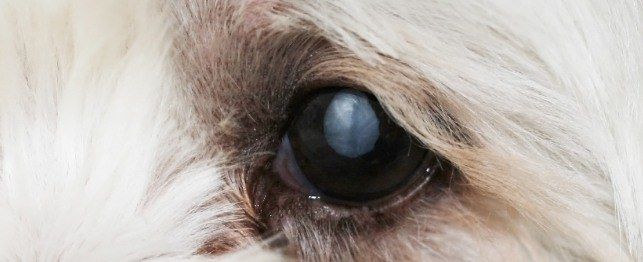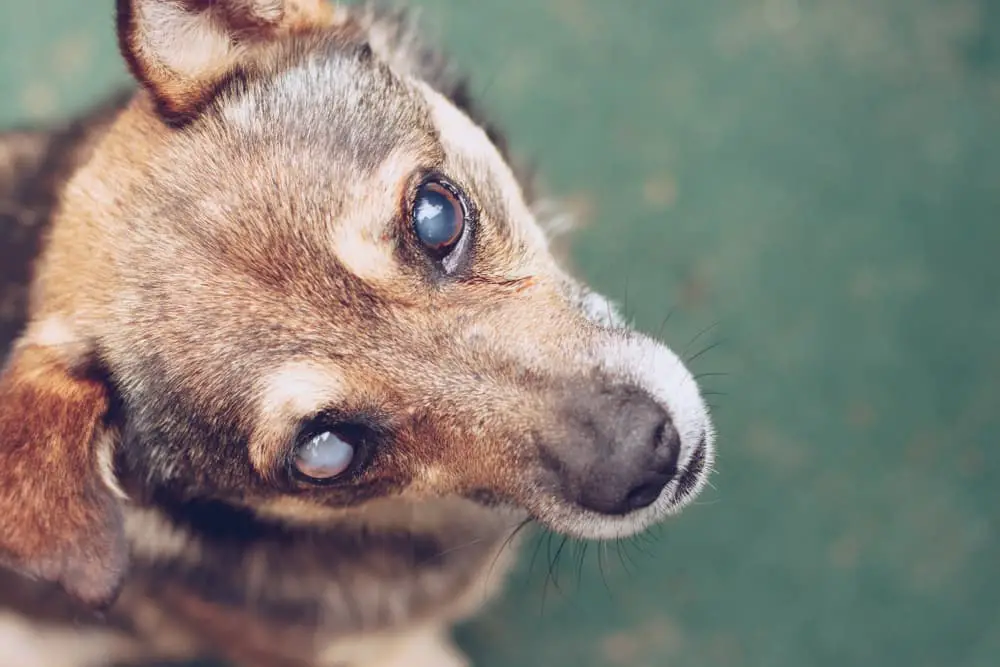Eye cataracts in dogs are very common, and in this post, we talk more about dogs with cataracts. I have seen cases where multiple dogs with cataracts belong to a single owner. In this case, I blame the owner and not nature (or old age) for the conditions of these dogs. You should know what to do to prevent cataracts in your dog(s) to avoid ending up like this owner.
Eye cataracts in dogs are very scary and scarier when your dog (or French bulldog) is diagnosed with one. Everything you need to know about this condition that could cause blindness in your pet is in this post.
Some people come to me asking how their dogs can get cataracts, thinking it is only peculiar to humans, but that’s not true. Dogs have eyes that contain pupils, lenses, and corneas. The only difference is that they see things differently than we do. So yes, it is possible to have dogs with cataracts.

You shouldn’t confuse cataracts with nuclear sclerosis, as they can be similar. The difference is that with nuclear sclerosis, your dog wouldn’t be blind. Nuclear sclerosis happens as a result of the hardening of the lens. The good news is that light would still be able to go through to contact the pet’s retina.
Both cataracts and nuclear sclerosis occur in dogs due to old age.
What Do you Do for a Dog with Cataracts?
The best way to remove eye cataracts in dogs is via surgery. It would help if you discussed these options with your dog’s vet doctor first. It would be the doctor who recommends surgery options for your pet.
Canine Cataracts
How Much Does it Cost to Remove Cataracts in Dogs?
According to Pawlicy, it would cost $2,700 – $4,000 for surgery on average to remove cataracts. Not everyone would be able to cough out that kind of money, which is one reason you should get pet insurance. You can read up about it here.
Do Cataract Eye Drops for Dogs Work?
It would be best if you discussed this option with the vet doctor. You shouldn’t just buy eye drops for your dog because a website says so. Understandably, there are a lot of trusted websites out there, and on this site, we publish what we are sure about, but going to a doctor is more reasonable before giving out eye drops for dogs with cataracts. It would help if you only did that because the doctor recommended it.
Can a Dog with Cataracts See Anything?
This depends on the size of cataracts. If it covers the whole lens, then there is no way the dog would be able to see a thing.
Are French Bulldogs Prone to Cataracts?
All dogs are prone to cataracts, like all humans, but some are more prone than others. A major reason is that the condition is hereditary and can be [passed down between generations. French bulldogs are a part of the dog breeds that are more prone to cataracts. All these breeds include:
- American Cocker Spaniel
- American Staffordshire Terrier
- Australian Shepherd
- Bichon Frise
- Boston Terrier
- Cocker Spaniel
- French Bulldog
- Havanese
- Labrador Retriever
- Miniature Schnauzer
- Poodle
- Siberian Husky
- Silky Terrier
- West Highland White Terrier
- Welsh Springer Spaniel
How to Diagnose Canine Cataracts (Symptoms of Eye Cataracts in Dogs)
Eye cataracts in dogs develop very slowly, and it might be too late before you realize your dog has cataracts. The best way to diagnose your Frenchie or whatever breed of dog you own is to make an appointment with your vet doctor. Doing this is the best way, especially if the cataracts are at the early stages and whereas the vet doctor would be able to check for other eye issues such as glaucoma.

Symptoms or signs of dogs with cataracts include:
- Eye color changes (especially if it turns white)
- Unusual and strange walking movements
- Teary eyes
- Squinting
- Bumping into avoidable and large objects
- Cloudy pupils
- Rubbing the eyes frequently
- Clumsiness
- Unwilling to climb places or jump over things
- Inability to see in dimly lit areas
Causes of Cataracts in Dogs
The major reasons why we do have cases of dogs with cataracts include the following:
- It is hereditary
- Major injuries to the eye
- It could be due to old age
- Inflammation in the eye could be another cause of eye cataracts in dogs.
- Diabetes
Preventing Dogs with Cataracts
We sincerely hope the number of dogs with cataracts can reduce if owners can do the following:
- Arranging regular checkups with the vet doctor.
- Make sure you give your dog extra attention, especially after having eye injuries.
- Once in a while, examine the dog’s eyes yourself. If you notice cloud-ish or blue-ish, you must visit the vet as soon as possible.
- If you also notice that your dog is having trouble walking, visit the vet doctor, as it may be the dog’s eyes.
- Be sure to know the dog’s parent’s medical history if possible (cataracts are often hereditary).
Treatment for Dogs with Cataracts
Untreated cataracts can lead to glaucoma and total blindness. The only way to treat dogs with cataracts is with surgery under anesthesia. Anesthesia might be risky if the dog has additional health issues, especially related to organs such as the kidney or the liver.
The good news is that there is a very high chance that the surgery will succeed, but the rate is lowered if the dog has a damaged retina and glaucoma.
The starting cost of a surgical operation to remove cataracts in a dog is $2,500, as pre-operative costs would add $1,000. The whole operation could be between $4,000 and more.
It is important to note that I (and the French Bulldog) am not a medical expert, and if you doubt any medical-related facts in this post or this website, you can cross-check with your doctor.





